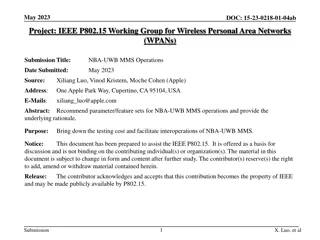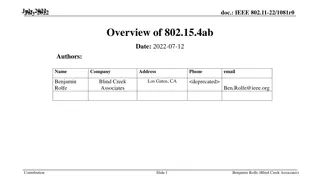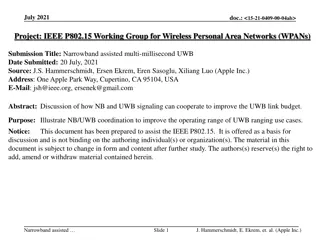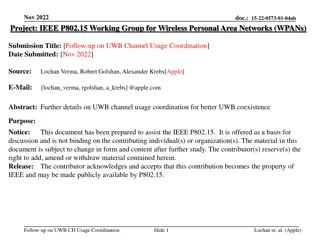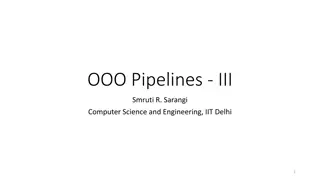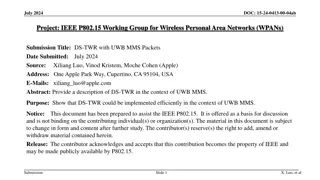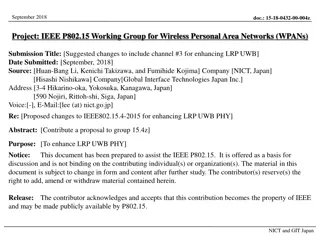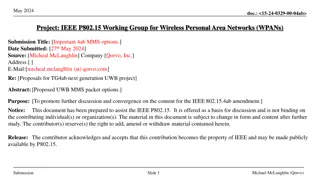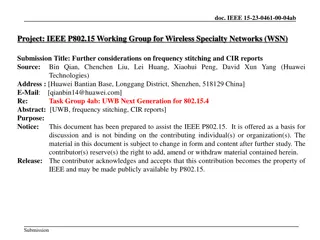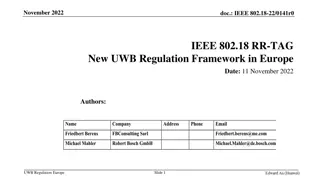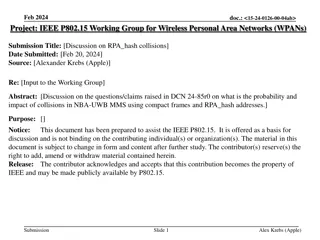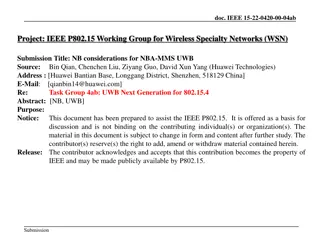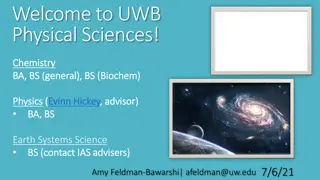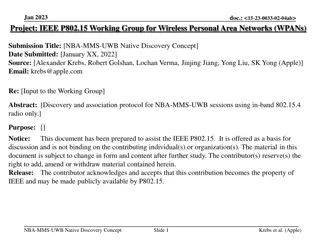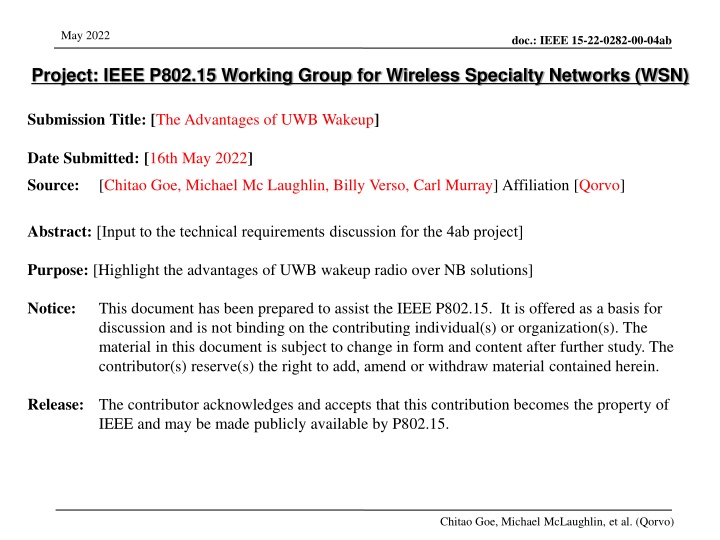
Unlocking the Benefits of UWB Wakeup Technology for Wireless Networks
Embrace the advantages of Ultra-Wideband (UWB) wakeup technology over Narrowband solutions for wireless networks. Learn how UWB wakeup radios offer low-power consumption and efficient communication to battery-powered devices, ensuring extended battery life. Discover the high link reliability and enhanced connectivity provided by UWB technology.
Download Presentation

Please find below an Image/Link to download the presentation.
The content on the website is provided AS IS for your information and personal use only. It may not be sold, licensed, or shared on other websites without obtaining consent from the author. If you encounter any issues during the download, it is possible that the publisher has removed the file from their server.
You are allowed to download the files provided on this website for personal or commercial use, subject to the condition that they are used lawfully. All files are the property of their respective owners.
The content on the website is provided AS IS for your information and personal use only. It may not be sold, licensed, or shared on other websites without obtaining consent from the author.
E N D
Presentation Transcript
May 2022 doc.: IEEE 15-22-0282-00-04ab Project: IEEE P802.15 Working Group for Wireless Specialty Networks (WSN) Submission Title: [The Advantages of UWB Wakeup] Date Submitted: [16th May 2022] Source: [Chitao Goe, Michael Mc Laughlin, Billy Verso, Carl Murray] Affiliation [Qorvo] Abstract: [Input to the technical requirements discussion for the 4ab project] Purpose: [Highlight the advantages of UWB wakeup radio over NB solutions] Notice: This document has been prepared to assist the IEEE P802.15. It is offered as a basis for discussion and is not binding on the contributing individual(s) or organization(s). The material in this document is subject to change in form and content after further study. The contributor(s) reserve(s) the right to add, amend or withdraw material contained herein. Release: The contributor acknowledges and accepts that this contribution becomes the property of IEEE and may be made publicly available by P802.15. Chitao Goe, Michael McLaughlin, et al. (Qorvo)
May 2022 doc.: IEEE 15-22-0282-00-04ab PAR Objective Safeguards so that the high throughput data use cases will not cause significant disruption to low duty-cycle ranging use cases Interference mitigation techniques to support higher density and higher traffic use cases Other coexistence improvement Backward compatibility with enhanced ranging capable devices (ERDEV Improved link budget and/or reduced air-time Additional channels and operating frequencies Improvements to accuracy / precision / reliability and interoperability for high-integrity ranging Proposal significantly reduce the power consumption of the companion radio for wakeup Reduced complexity and power consumption Hybrid operation with narrowband signaling to assist UWB Allows a UWB transmitter to address individual devices and to wake them up Enhanced native discovery and connection setup mechanisms Sensing capabilities to support presence detection and environment mapping Low-power low-latency streaming Higher data-rate streaming allowing at least 50 Mbit/s of throughput Support for peer-to-peer, peer-to-multi-peer, and station-to-infrastructure protocols Infrastructure synchronization mechanisms Chitao Goe, Michael McLaughlin, et al. (Qorvo) Slid2
May 2022 doc.: IEEE 15-22-0282-00-04ab The Advantages of UWB Wakeup A Low-Power Wake-Up Radio (LP-WUR) Chitao Goe, Michael McLaughlin, et al. (Qorvo) Slide3
May 2022 doc.: IEEE 15-22-0282-00-04ab Introduction The major aim of UWB wakeup To initiate communication to battery-powered devices which require years of battery life UWB wakeup radio can achieve high link margin and very low power In our previous contribution [1], a design concept backed up by 22nm CMOS circuit simulation has been presented In this contribution, a review of BLE and Wi-Fi wakeup radio designs from University and Industry is carried out and the advantages of UWB wakeup radio are highlighted. [1] Michael Mclaughlin et al., UWB Wakeup Signalling, ,doc.:<15-21-0557-00-04ab>. Chitao Goe, Michael McLaughlin, et al. (Qorvo) Slide4
May 2022 Initiate Comms to Battery-Powered Devices LP-WUR approach to Escape the Duty-Cycle Trap doc.: IEEE 15-22-0282-00-04ab Bluetooth Low Energy Approach: Back-channel (BC) communication Wi-Fi Approach: 802.11ba UWB Approach: currently lack of LP-WUR, except a proposal [1] Duty-Cycle Trap [2] To increase battery life, a device needs to sleep more increased latency To receive data with low latency, a device needs to sleep less shorter battery life [2] M. Park, S. Azizi, R. Stacey, and J. Liu, Low-Power Wake-Up Receiver (LP-WUR) for 802.11, IEEE Standard 802.11-15/1307r1, Nov. 2015. Chitao Goe, Michael McLaughlin, et al. (Qorvo) Slide5
May 2022 doc.: IEEE 15-22-0282-00-04ab WUR Design Constraints to Achieve Low Power (1) Standard Compatible Wakeup Signal UWB wakeup signal enables low power demodulation Bluetooth Low Energy Non-standardized wakeup signal A sub-mW receiver to demodulate the GFSK symbols is not feasible Back Channel Communication[3] Wakeup address encoded into the sequence order of advertising packet, channels and event Wi-Fi Standardized wakeup signal MC-OOK with rate Manchester coding 64-bit long WUR LDR frame duration: 920 us [4] [5] UWB One bit encoded to 4 s of 4z like, STS sequence [1] Multi-bit preamble and 16-bit address [3] N. E. Roberts et al., "26.8 A 236nW 56.5dBm-sensitivity bluetooth low-energy wakeup receiver with energy harvesting in 65nm CMOS," 2016 IEEE International Solid-State Circuits Conference (ISSCC), 2016 [4] A. Alghaihab, J. Breiholz, H. Kim, B. Calhoun and D. D. Wentzloff, "A 150 W 57.5 dBm-Sensitivity Bluetooth Low-Energy Back-Channel Receiver with LO Frequency Hopping," 2018 IEEE Radio Frequency Integrated Circuits Symposium (RFIC), 2018 [5] R. Liu et al., "An 802.11ba-Based Wake-Up Radio Receiver With Wi-Fi Transceiver Integration," in IEEE Journal of Solid-State Circuits, vol. 55, no. 5, pp. 1151-1164, May 2020 [1] Chitao Goe, Michael McLaughlin, et al. (Qorvo) Slide6
May 2022 doc.: IEEE 15-22-0282-00-04ab WUR Design Constraints to Achieve Low Power (2) Interference Resiliency UWB requires less stringent Interference Resiliency Bluetooth Low Energy The 2.4 GHz ISM band is highly congested by multiple wireless standards Enhance interference resiliency by compromising power consumption Wi-Fi In congested 2.4G and 5G channel, it is very restricted to schedule available airtime for wakeup call Operating in crowded band, LP-WUR has to achieve very good signal-to interference ratio in order to meet sensitivity target by tolerating a very strong adjacent channel Wi-Fi blocker (-40dBm) UWB 8 GHz band is less congested Potential narrow-band jammers are in other far away channels Chitao Goe, Michael McLaughlin, et al. (Qorvo) Slide7
May 2022 WUR Design Constraints to Achieve Low Power (3) Duty Cycle Operation UWB can effectively take advantage of low duty cycle operation doc.: IEEE 15-22-0282-00-04ab Bluetooth Low Energy Lack of dedicated protocol to schedule duty cycle for the listen and wakeup time Crowded channel restricts low duty cycle operation BLE Tx cannot occupy large portion of airtime to reduce the LP-WUR listen time Wi-Fi Coordinated Target Wake Time (TWT) protocol (AP involved) to schedule (not always possible) the listening and wakeup (TWT doesn t guarantee STA wakes up when the wakeup call arrives) Constrained air-time prevents low duty cycle operation UWB Uncoordinated protocol (suits for event-driven traffic) TX sends one 4 s burst for per 1 ms and consecutively for twenty 1 s preamble while WUR listens 1ms in every 20 ms (5% duty cycle) Sequence length and listening time can be further traded off for latency and power consumption [4] [1] Chitao Goe, Michael McLaughlin, et al. (Qorvo) Slide8
May 2022 doc.: IEEE 15-22-0282-00-04ab LP-WUR Design Trade-offs Power, Latency, Sensitivity and Selectivity High Power High Latency Sensitivity WiFi Selectivity Always On High gain amp High order filter Mixer w/ LO High order filter Channel Hopping BLE Duty Cycle Packet Level Bit Level UWB Envelop Detector Low gain amp Relaxed filter Low-Power Low Power Chitao Goe, Michael McLaughlin, et al. (Qorvo) Slide9
May 2022 doc.: IEEE 15-22-0282-00-04ab Review on BLE and UWB LP-WUR Publications Sensitivity (dBm) Link Margin (dB) Power Consumption ( W) Battery Life (year) Signal to Interference Ratio (dB) Latency (ms) 10 4 -31 UWB - [15-21-0557] -110 96 50 CICC 2018 - MIT -80 90 230 0.17 Not Reported 0.2 JSSC 2019 - UV -82.2 92.2 1200 0.03 -10 0.2 JSSC 2021 - UCSD -85 95 220 0.18 -6 0.2 JSSC 2021 - UCSD -92 102 352 0.11 -12.5 0.2 Notes: 1) Link Margin for BLE WUR: BLE back-channel communication advertising packet Tx power=+10dBm. 2) Signal to Interference Ratio: Adjacent Channel BLE Jammer@2MHz; For UWB simulated by 20MHz Wi-Fi Jammer@8MHz. 3) Power Consumption: for UWB, calculated by 3% UWB Duty cycle; for BLE WUR 100% duty cycle. 4) Battery Life: details in backup slide 1. 5) Latency: for UWB, 3% duty cycle worse case latency that preamble is detected at the 33ms; for BLE, its 100% duty cycle operation so the latency is only the reception time to demodulate the advertising packet/event. References CICC 2018 : M. R. Abdelhamid, A. Paidimarri and A. P. Chandrakasan, "A 80dBm BLE-compliant, FSK wake-up receiver with system and within-bit dutycycling for scalable power and latency," 2018 IEEE Custom Integrated Circuits Conference (CICC), 2018. JSSC 2019 : A. Alghaihab, Y. Shi, J. Breiholz, H. Kim, B. H. Calhoun and D. D. Wentzloff, "Enhanced Interference Rejection Bluetooth Low-Energy Back-Channel Receiver With LO Frequency Hopping," in IEEE Journal of Solid-State Circuits, vol. 54, no. 7, pp. 2019-2027, July 2019. JSSC 2021 : P. -H. P. Wang and P. P. Mercier, "An Interference-Resilient BLE-Compatible Wake-Up Receiver Employing Single-Die Multi-Channel FBAR-Based Filtering and a 4-D Wake-Up Signature," in IEEE Journal of Solid-State Circuits, vol. 56, no. 2, pp. 416-426, Feb. 2021. JSSC 2021 : P. -H. P. Wang and P. P. Mercier, "A Dual-Mode Wi-Fi/BLE Wake-Up Receiver," in IEEE Journal of Solid-State Circuits, vol. 56, no. 4, pp. 1288-1298, April 2021. Chitao Goe, Michael McLaughlin, et al. (Qorvo) Slide10
May 2022 doc.: IEEE 15-22-0282-00-04ab Review on Wi-Fi and UWB LP-WUR Sensitivity (dBm) Margin (dB) ( W) Publications Link Power Consumption Battery Life (year) Signal to Interference Ratio (dB) Latency (ms) 10 4 UWB - [15-21-0557] -110 96 -33 50 VLSI 2019 - Intel -92.4 105.4 340 0.12 -32.4 0.92 TMTT 2019 - UM -83 96 220 0.18 -20 0.92 RFIC 2020 - UV -91.5 104.5 578 0.07 -45 0.92 JSSC 2020 - Intel -92.6 105.6 495 0.08 -49 0.92 Notes: 1) Link Margin: for the 2.4GHz WiFi OFDM Tx max power=5 mW/MHz, the 4MHz WUR max Tx power=+13 dBm. 2) Signal to Interference Ratio: the SIR tested (simulated for UWB) by Wi-Fi Jammer Adjacent Channel @25MHz. 3) Power Consumption: for UWB, calculated by 3% UWB duty cycle; for WiFi WUR 100% duty cycle. 4) Battery Life: details in backup slide 1. 5) Latency: for UWB, 3% duty cycle worse case latency that preamble is detected at the 33ms; for Wi-Fi, it s 100% duty cycle operation, the latency is only the reception time to demodulate the WUR frame. References: VLSI 2019 : R. Dorrance et al., "An Ultra-Low Power, Fully Integrated Wake-Up Receiver and Digital Baseband with All-Digital Impairment Correction and -92.4dBm Sensitivity for 802.11ba," 2019 Symposium on VLSI Circuits, 2019. TMTT 2019 : J. Im, H. Kim and D. D. Wentzloff, "A 220- u W 83-dBm 5.8-GHz Third-Harmonic Passive Mixer-First LP-WUR for IEEE 802.11ba," in IEEE Transactions on Microwave Theory and Techniques, vol. 67, no. 7, pp. 2537-2545, July 2019. RFIC 2020 : J. Im, J. Breiholz, S. Li, B. Calhoun and D. D. Wenzloff, "A Fully Integrated 0.2V 802.11ba Wake-Up Receiver with -91.5dBm Sensitivity," 2020 IEEE Radio Frequency Integrated Circuits Symposium (RFIC), 2020. JSSC 2020 : R. Liu et al., "An 802.11ba-Based Wake-Up Radio Receiver With Wi-Fi Transceiver Integration," in IEEE Journal of Solid-State Circuits, vol. 55, no. 5, pp. 1151-1164, May 2020. Chitao Goe, Michael McLaughlin, et al. (Qorvo) Slide11
May 2022 doc.: IEEE 15-22-0282-00-04ab Summary Today s ubiquitous BLE and Wi-Fi networks adopt LP-WUR to initiate communication to battery-powered devices but make trade-offs between low power consumption, latency and interference resilience Today s UWB doesn t have a wakeup radio solution The UWB wakeup proposal [1] not only escapes the duty-cycle trap but also achieves very low power consumption (4-years battery life) without compromising the interference resiliency, sensitivity and latency Operating in much less congested 8 GHz band facilitates low duty cycle operation Simple wakeup signature enables the implementation of low power architecture The proposal paves the way of applying UWB wakeup as companion radio to wake up BLE, Wi-Fi and UWB devices Chitao Goe, Michael McLaughlin, et al. (Qorvo) Slide12
May 2022 doc.: IEEE 15-22-0282-00-04ab Backup Slides Chitao Goe, Michael McLaughlin, et al. (Qorvo) Slide13
May 2022 doc.: IEEE 15-22-0282-00-04ab 1. How much current can WuRx draw? CR2032 Capacity Average Vbat Energy Vdd Lifetime DCDC Efficiency Average Cont Current 225 mAh 2.9 V 2349 Joules 1.2 V 4 years 65% 10.09 A Chitao Goe, Michael McLaughlin, et al. (Qorvo) Slide14


